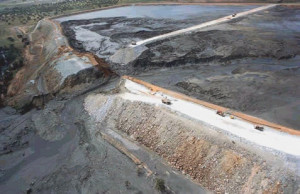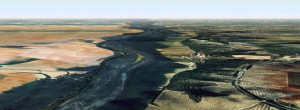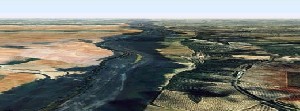The dike on a storage basin for pyrite mining waste broke over a 50-m length following a landslide. 4 million tonnes of acidic water plus 3 million tonnes of sludge containing Zn, Fe, Cu, Pb and As (0.3 g/l) reached the RIO AGRIO River and then the GUADIAMAR, spilling over a 200-m to 300-m stretch on a 20-km course. This toxic flow threatened Spain’s Donana National Park, surrounding which emergency teams set up earthen embankments. At the same time, local authorities ordered the construction of dams to confine the majority of pollution in the Entremuros Canal (overflows still wound up flooding adjacent farmland); some pollutants reached the GUADALQUIVIR Delta, 80 km downstream of the mine, polluting Gulf of Cadiz beaches. Effluent infiltrated into the water table, which serves as the primary water supply source for both the National Park and the city of Seville. The wastes contaminated 7,000 ha of pastureland and marshland and another 3,500 ha of cropland. This accident caused the death of 30 tonnes of fish, tens of thousands of birds (geese, storks, etc.), 220 kg of shellfish, and frogs, horses and goats. A few people were slightly burnt by the acidic water while trying to save livestock. Hunting, fishing and water consumption (irrigation, drinking water pumping, etc.) were all prohibited for several weeks.
The decontamination process lasted 8 months; 5 million m³ of sludge and 2 million m³ of stripped farmland were recovered and stored in a former mine. 4.5 million m³ of water held in the Entremuros Canal were treated at a water treatment plant and then discharged into the GUADALQUIVIR. The authorities activated a monitoring and quality restoration plan for the water and soil; moreover, in 2004, they launched a programme to replant vegetation on the affected riverbanks. The ensuing drainage work, agricultural losses and authority repurchase of contaminated lands amounted to a total cost €240 million. The mine, closed for 12 months subsequent to the accident (500 employees made redundant), was definitively shut down in September 2001.
This accident was caused by a 1-m slip of the 600-m², 14-m thick marly plate supporting the dike. A team of university experts uncovered a series of design flaws, in addition to citing the excessive level of basin filling. Several expert evaluation reports had previously revealed (in 1996) vulnerabilities in the clayey underlying ground and dike instabilities. The accidents at Aznalcollar, Baia Mare (ARIA 17265) and Bucharest (ARIA 17425) led to tightening European legislation on mining waste management.
Download the detailed report in .pdf format (1.3 Mb)







